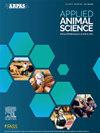Sorghum-sudangrass intercropped with cowpea improved pasture for stocker cattle in the mid-south
IF 1.5
Q3 AGRICULTURE, DAIRY & ANIMAL SCIENCE
引用次数: 0
Abstract
Objective
The objective of this study was to evaluate forage production and nutrient composition and stocker cattle performance on mixed bermudagrass, sorghum-sudangrass, and sorghum-sudangrass-cowpeas pastures.
Materials and Methods
In summers of 2021 and 2022, 144 steers (8 per experimental unit) were assigned to 1 of 3 grazing treatments (2.02 ha each): mixed bermudagrass (MB), mixed bermudagrass overseeded with sorghum-sudangrass (SS), or mixed bermudagrass overseeded with sorghum-sudangrass and cowpea (SSCW), in a randomized complete block design with 3 replications each.
Results and Discussion
Forage mass was greater in SS than MB in August 2021 and September of both years, whereas SSCW forage mass was only greater than MB in September 2022. Neutral detergent fiber was lower for SS in September 2021 and lower for SS and SSCW in July and August 2022 compared with MB. Across years and months, cowpea proportion averaged only 12.4%. Timing of N fertilization caused differences in CP among mixtures, although CP was greater in SSCW than SS in August and September 2021. Average daily gain was greater in SS and SSCW in both years (1 kg/d for SS and SSCW, and 0.8 kg/d for MB). Gain per hectare had a year × treatment interaction, with similar gain per hectare in 2021 and greater gain per hectare in SS compared with MB in 2022.
Implications and Applications
Greater available forage mass in SS in August and September may fill gaps in MB systems while also improving ADG, even under moisture-limited conditions. However, when planting was delayed, SS and SSCW provided fewer grazing days than MB and, despite the increased ADG, could not compensate, and gain per hectare was similar among pasture treatments.
中南部高粱苏丹草间作豇豆改良牧场放牧牛
材料与方法 2021 年和 2022 年夏天,144 头母牛(每个实验单元 8 头)被分配到 3 个放牧处理(各 2.02 公顷)中的 1 个:混合百慕大草(MB)、混合百慕大草与高粱-苏丹草(SS)或混合百慕大草与高粱-苏丹草-豇豆(SS)。结果与讨论2021 年 8 月和 2022 年 9 月,SS 的贮草量高于 MB,而 SSCW 的贮草量仅高于 MB。与甲基溴相比,2021 年 9 月 SS 的中性洗涤纤维较低,2022 年 7 月和 8 月 SS 和 SSCW 的中性洗涤纤维较低。在不同年份和月份,豇豆的平均比例仅为 12.4%。氮肥施用的时间造成了不同混合物中 CP 的差异,尽管在 2021 年 8 月和 9 月,SSCW 的 CP 高于 SS。这两年,SS 和 SSCW 的平均日增重更大(SS 和 SSCW 为 1 千克/天,MB 为 0.8 千克/天)。每公顷增重与年份×处理有交互作用,2021 年每公顷增重相似,2022 年 SS 的每公顷增重高于 MB。然而,当播种推迟时,SS 和 SSCW 的放牧天数少于 MB,尽管 ADG 有所提高,但仍无法弥补,而且不同牧草处理的每公顷增重相似。
本文章由计算机程序翻译,如有差异,请以英文原文为准。
求助全文
约1分钟内获得全文
求助全文

 求助内容:
求助内容: 应助结果提醒方式:
应助结果提醒方式:


